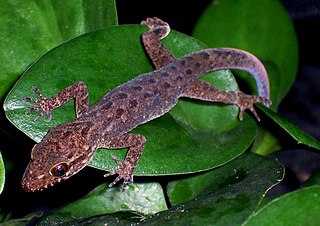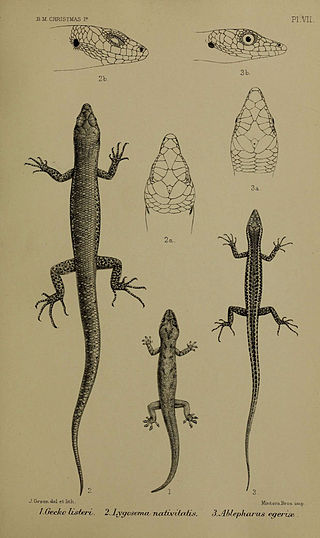
Phelsuma is a large genus of geckos in the family Gekkonidae. Species in the genus Phelsuma are commonly referred to as day geckos.

Gekkonidae is the largest family of geckos, containing over 950 described species in 62 genera. The Gekkonidae contain many of the most widespread gecko species, including house geckos (Hemidactylus), the tokay gecko (Gekko), day geckos (Phelsuma), the mourning gecko (Lepidodactylus), and dtellas (Gehyra). Gekkonid geckos occur globally and are particularly diverse in tropical areas. Many species of these geckos exhibit an adhering ability to surfaces through Van der Waals forces utilizing intermolecular forces between molecules of their setae and molecules of the surface they are on.

Pasteur's day gecko is a small diurnal subspecies of gecko. It lives in the Comoros and typically inhabits trees and bushes. Pasteur's day gecko feeds on insects and nectar.

Gehyra is a genus of geckos in the family Gekkonidae. They are known as web-toed geckos or dtellas, and most species within the genus bear close resemblance to geckos from the genus Hemidactylus.

Cyrtodactylus is a diverse genus of Asian geckos, commonly known as bent-toed geckos, bow-fingered geckos, and forest geckos. The genus has 361 described species as of 2024, which makes it the largest of all gecko genera.

Eurydactylodes is a small genus of geckos commonly referred to as chameleon geckos from the subfamily Diplodactylidae, endemic to New Caledonia and few adjacent islands. Within the Diplodactylidae, Eurydactylodes resides in the Carphodactylini tribe, and consists of four species. All species share similar morphology as well as lifestyle and habits. The first of the Eurydactylodes species to be classified, E. vieillardi, was discovered in 1869.
The western beaked gecko is a species of gecko found throughout the interior of Australia.

Christinus marmoratus, also known as marbled gecko or southern marbled gecko, is a species of Gekkonidae (gecko) native to southern mainland of Australia, from Victoria to Western Australia. The species is well adapted to a variety of habitats, including city dwellings..

The Auckland green gecko, also known as the elegant gecko, is a species of gecko found only in the northern half of the North Island of New Zealand, except north of Whangaroa.

Lepidodactylus listeri, also known commonly as Lister's gecko or the Christmas Island chained gecko, is a species of gecko, a lizard in the family Gekkonidae, endemic to Christmas Island in the Indian Ocean. It is currently extinct in the wild.
Christinus guentheri is a species of lizard in the family Gekkonidae (geckos). The species is endemic to two Australian islands, Norfolk Island and Lord Howe Island.

The Serpent Island gecko is a species of lizard in the family Gekkonidae. The species is endemic to Mauritius.

Morelia imbricata is a large snake found in southern regions of Western Australia and western South Australia. A member of the python family, it is commonly known as the southwestern carpet python.
Christinus alexanderi, also known as Alexander's southern gecko or Alexander's marbled gecko, is a species of Gekkonidae geckos found in the Nullarbor Plain of Australia. It is one of the many species and subspecies regionally termed as marbled geckos.

The south-western spiny-tailed gecko, also known commonly as the soft spiny-tailed gecko, is a species of lizard in the family Diplodactylidae. The species is endemic to Australia. Two subspecies are recognized.
C. alexanderi may refer to:

Chondrodactylus angulifer, also known as the common giant ground gecko, the South African ground gecko, or the Namib sand gecko, is a species of gecko, a lizard in the family Gekkonidae. The species is endemic to southern Africa.
Wahlberg's Kalahari gecko, also known commonly as the Kalahari ground gecko, is a species of lizard in the family Gekkonidae. The species is native to southern Africa.

The Durrell's night gecko is a species of lizard in the family Gekkonidae. The species is endemic to the Round Island of Mauritius.














